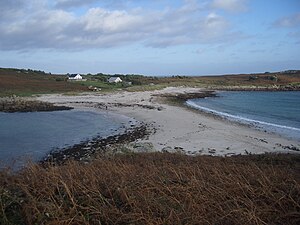Gugh
| Gugh | ||
|---|---|---|
| St. Agnes and Gugh | ||
| Waters | Celtic sea | |
| Archipelago | Isles of Scilly | |
| Geographical location | 49 ° 53 '47 " N , 6 ° 19' 58" W | |
|
|
||
| length | 1 km | |
| width | 500 m | |
| surface | 50 ha | |
| Highest elevation | Kittern Hill 34 m ASL |
|
| Residents | 3 (2001) 6 inhabitants / km² |
|
|
Gugh and the tombolo The Bar , which connects the island with St. Agnes |
||
Gugh ( Cornish Keow ) is an island in the Isles of Scilly . The island is about one kilometer long and half a kilometer wide. At its highest point, Kittern Hill , Gugh is 34 m above sea level. The island is connected to St. Agnes by the only 60 meter wide tombolo The Bar , which separates The Cove in the south from the Forth Conger in the north .
The granite , of which the island is mainly made, was created during the Variscan orogeny .
There are several Cairns ( Obadiah's Barrow ) and menhirs on the island . In particular, the 2.40 m high Old Man of Gugh is a popular photo opportunity with tourists.
In the 17th century, the production of sodium carbonate from kelp began on Gugh . The complex process of drying and burning the seaweed to produce salt for glass production was only abandoned at the end of the 19th century when more economical, industrial methods became available.
fauna and Flora
The island is a Site of Special Scientific Interest and is co-managed by the Isles of Scilly Wildlife Trust . Sea eagles , garden shrews , wild rabbits , Atlantic shearers and petrels are native to Gugh . The island has a great variety of plants. Cladonia , blackberries , common lung lichen, common adder's head , yellow sweet clover , yellow woof , long-haired thyme , sticky seeds , beach thistle , beach spurge and beach bindweed grow here .
Attempts to eradicate the rat plague on the island have so far failed.
Web links
- AONB (Eng.)
- Isle of Scilly Wildlife Trust (Engl.)
- Pictures of the Bronze Age plants on the island (Engl.)


